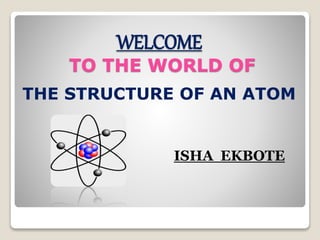
Structure of an Atom Explained: Atomic Models, Particles, Isotopes
- 1. WELCOME TO THE WORLD OF THE STRUCTURE OF AN ATOM ISHA EKBOTE
- 2. THIS WORLD CONTAINS 5 CONTINENTS NAMELY: WHAT IS AN ATOM ? DISCOVERY OF AN ATOM THE PARTICLES OF AN ATOM ATOMIC NUMBER ; MASS NUMBER AND WEIGHTS ISOTOPES
- 3. AN ATOM An atom is the smallest particle of an element. Atoms come together to make molecules or particles . There are many different types of atoms, each with its own name , mass and size. They themselves are made up of 3 kinds of particles , protons (positively charged), neutrons (have no charge) and electorns (negatively charged). In atoms the no. of protons and no. of elelctrons are equal.
- 4. DISCOVERY OF AN ATOM In 1803 John Dalton gave the first systematic idea of the structure of the atom. He suggested that, atoms are small particles and they are indivisible. Atoms cannot be created or destroyed. Atom is the smallest unit of matter that takes part in a chemical reaction. In 1897, sir J.J.Thomson discovered electron. He carried out detailed and concluded that atom is not the last and ultimate particle of matter but consists of some fundamental particles negative & positive charge.
- 5. These particles were called as electrons and protons respectively. According to Thomson’s model, atom was supposed to be a homogeneous sphere of positive charge, negatively charged electrons are embedded in it. In 1911, Ernest Rutherford suggested that atom is a hollow sphere and most of the mass of the is concentrated in the of the atom.
- 6. J.J. THOMSON
- 7. THOMSON’S ATOMIC MODEL As per Thomson’s atomic model, atom is solid. There is no empty space. There is no nucleus in the Thomson’s atomic model. The positive charge in the atom is uniformly distributed.
- 8. THOMSON’S ATOMIC MODEL Spherical cloud of positive charge Electrons
- 10. RUTHERFORD’S ATOMIC MODEL As per Rutherford’s atomic model atom is hollow. With lot of empty space. The nucleus is at the center of the as per Rutherford’s atomic model. The positive charge is concentrated in the nucleus. Electrons revolve around the nucleus in specific orbit.
- 11. RUTHERFORD’S ATOMIC MODEL Nucleus (proton & neutron) Electrons Electronic Orbits
- 12. NEILS BOHR
- 13. NEILS BOHR ATOMIC MODEL Neil Bohr in 1913, specified the distribution of electrons in different orbits. Bohr’s model of an atom suggest no. of circular orbits around the nucleus, in which electrons are distributed. He thought of an atom as a tiny solar system, nucleus as the sun and electrons as the planets. Thus according to him atom is made up of 2 parts, nucleus and extra-nuclear part.
- 14. NEILS BOHR’S ATOMIC MODEL Electrons Orbit Nucleus
- 15. THE PARTICLES OF AN ATOM
- 16. PROTONS The protons have a positive charge. Protons are represented by the (p+). Protons are situated in the nucleus of an atom. The number of protons in the nucleus determines what chemical element the atom belongs to. The mass of proton is considered to 1 unit.
- 17. ELECTRONS Electrons have a negative charge. They are represented by the symbol (e-). Electrons revolve around the nucleus in specific orbit. The mass of electron is negligible. The electrons in an atom are bound to the atom by the electromagnetic force.
- 18. NEUTRONS Neutrons are neutral as they do not have any charge. They are represented by the symbol(n). Neutrons are situated in the nucleus of an atom. The mass of neutrons is nearly equal to the mass of the protons. The number of neutrons determines what isotope of the element it is.
- 19. ATOMIC NUMBER & ATOMIC MASS NUMBER & ATOMIC WEIGHTS
- 20. ATOMIC NUMBER The number of protons and electrons in an atom is called the atomic number. The atomic number is represented by the symbol(Z). All atoms of same element have same atomic number. The atomic number uniquely identifies a chemical element .
- 21. ATOMIC MASS NUMBER Atomic mass number (A) is equal to the sum of the number of protons and neutrons in the nucleus. Atomic mass number is represented by the symbol (A). Isotopes same element have different atomic number. The atomic number is always an integral number.
- 22. ATOMIC WEIGHTS The relative weight of an atom of an element is called the atomic weight of the element. The weight of atoms is very small. Hence it is convenient to give their actual weights. ATOMIC WEIGHT OF ELEMENT=AVERAGE WEIGHT OF ATOMS OF ELEMENT WEIGHT OF AN ATOM OF HYDROGEN EG:- Hydrogen = 1 Oxygen = 16 Nitrogen =14
- 23. ISOTOPES & IT’S PROERTIES Atoms of the same element having same atomic no.& but different atomic mass no. are called as isotopes of that element. Properties on isotopes:- Isotopes exhibit same chemical properties. Isotopes differ in physical constants and weights. Isotopes occupy the same position in periodic table.
- 24. ISOTOPES OF HYDROGEN Hydrogen has 3 isotopes, protium, deuterium and tritium having 1 ,2 and 3 respectively. They have 1 proton and 1 electro each , but deutrium has 1 and tritium has 2 neutrons respesctively
- 25. THANK YOU